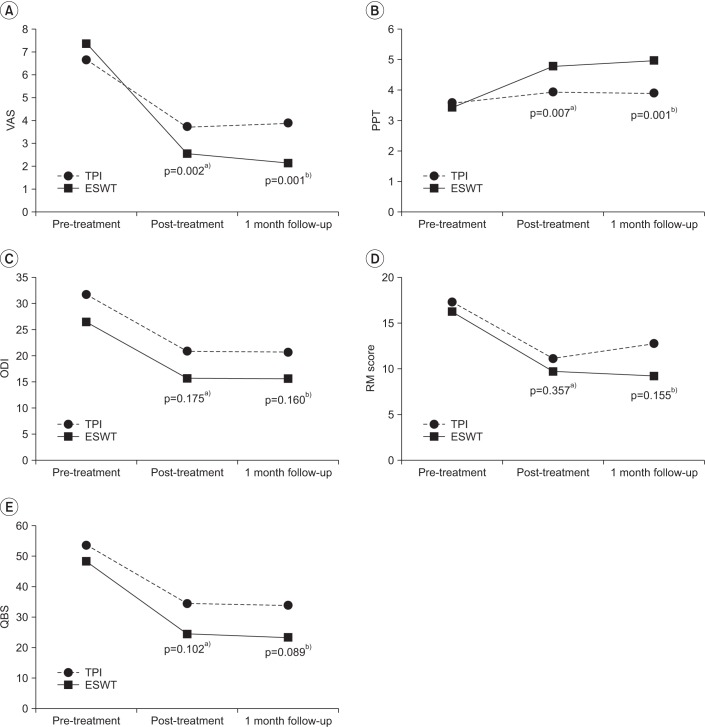Extracorporeal Shock Wave Therapy Versus Trigger Point Injection in the Treatment of Myofascial Pain Syndrome in the Quadratus Lumborum
- Affiliations
-
- 1Department of Rehabilitation Medicine and Rehabilitation, Institute of Neuromuscular Disease, Yonsei University College of Medicine & Gangnam Severance Hospital, Seoul, Korea. RMPJH@yuhs.ac
- KMID: 2389403
- DOI: http://doi.org/10.5535/arm.2017.41.4.582
Abstract
OBJECTIVE
To compare the effectiveness of extracorporeal shock wave therapy (ESWT) and trigger point injection (TPI) for the treatment of myofascial pain syndrome in the quadratus lumborum.
METHODS
In a retrospective study at our institute, 30 patients with myofascial pain syndrome in the quadratus lumborum were assigned to ESWT or TPI groups. We assessed ESWT and TPI treatment according to their affects on pain relief and disability improvement. The outcome measures for the pain assessment were a visual analogue scale score and pain pressure threshold. The outcome measures for the disability assessment were Oswestry Disability Index, Roles and Maudsley, and Quebec Back Pain Disability Scale scores.
RESULTS
Both groups demonstrated statistically significant improvements in pain and disability measures after treatment. However, in comparing the treatments, we found ESWT to be more effective than TPI for pain relief. There were no statistically significant differences between the groups with respect to disability.
CONCLUSION
Compared to TPI, ESWT showed superior results for pain relief. Thus, we consider ESWT as an effective treatment for myofascial pain syndrome in the quadratus lumborum.
Keyword
MeSH Terms
Figure
Cited by 3 articles
-
어깨-목 통증증후군에서 체외충격파치료의 효능
Joon Yub Kim, Jae Yoon Kim, Jong Pil Yoon, Seok Won Chung, Dong-Hyun Kim, Yoo-Sun Won
Korean J Sports Med. 2020;38(4):208-216. doi: 10.5763/kjsm.2020.38.4.208.Efficacy of Extracorporeal Shockwave Therapy on Cervical Myofascial Pain Following Neck Dissection Surgery: A Randomized Controlled Trial
FatmaAlzahraa Hassan Kamel, Maged Basha, Ashwag Alsharidah, Islam Mohamed Hewidy, Mohamed Ezzat, Nancy Hassan Aboelnour
Ann Rehabil Med. 2020;44(5):393-401. doi: 10.5535/arm.20055.Combined Effects of Extracorporeal Shockwave Therapy and Integrated Neuromuscular Inhibition on Myofascial Trigger Points of Upper Trapezius: A Randomized Controlled Trial
Dina Al-Amir Mohamed, Ragia Mohamed Kamal, Manal Mohamed Gaber, Yasser M. Aneis
Ann Rehabil Med. 2021;45(4):284-293. doi: 10.5535/arm.21018.
Reference
-
1. Simons DG, Travell J. Myofascial trigger points, a possible explanation. Pain. 1981; 10:106–109. PMID: 7232007.2. Novikova LB, Akopyan AP. Myofascial pain syndrome. Zh Nevrol Psikhiatr Im S S Korsakova. 2015; 115:21–24.
Article3. Chen CK, Nizar AJ. Myofascial pain syndrome in chronic back pain patients. Korean J Pain. 2011; 24:100–104. PMID: 21716607.
Article4. Jafri MS. Mechanisms of myofascial pain. Int Sch Res Notices. 2014; 2014.
Article5. Sabatke S, Scola RH, Paiva ES, Kowacs PA. Injection of trigger points in the temporal muscles of patients with miofascial syndrome. Arq Neuropsiquiatr. 2015; 73:861–866. PMID: 26465403.6. Borg-Stein J, Iaccarino MA. Myofascial pain syndrome treatments. Phys Med Rehabil Clin N Am. 2014; 25:357–374. PMID: 24787338.
Article7. Moon SW, Kim JH, Jung MJ, Son S, Lee JH, Shin H, et al. The effect of extracorporeal shock wave therapy on lower limb spasticity in subacute stroke patients. Ann Rehabil Med. 2013; 37:461–470. PMID: 24020026.
Article8. Shrivastava SK, Kailash . Shock wave treatment in medicine. J Biosci. 2005; 30:269–275. PMID: 15933416.
Article9. Ji HM, Kim HJ, Han SJ. Extracorporeal shock wave therapy in myofascial pain syndrome of upper trapezius. Ann Rehabil Med. 2012; 36:675–680. PMID: 23185732.
Article10. Simons DG, Mense S. Diagnosis and therapy of myofascial trigger points. Schmerz. 2003; 17:419–424. PMID: 14648314.11. Vecchiet L, Giamberardino MA, Saggini R. Myofascial pain syndromes: clinical and pathophysiological aspects. Clin J Pain. 1991; 7(Suppl 1):S16–S22. PMID: 1810517.12. Delaney GA, McKee AC. Inter- and intra-rater reliability of the pressure threshold meter in measurement of myofascial trigger point sensitivity. Am J Phys Med Rehabil. 1993; 72:136–139. PMID: 8512674.
Article13. Park SW, Shin YS, Kim HJ, Lee JH, Shin JS, Ha IH. The dischargeable cut-off score of Oswestry Disability Index (ODI) in the inpatient care for low back pain with disability. Eur Spine J. 2014; 23:2090–2096. PMID: 25099873.
Article14. Mousavi SJ, Parnianpour M, Mehdian H, Montazeri A, Mobini B. The Oswestry Disability Index, the Roland-Morris Disability Questionnaire, and the Quebec Back Pain Disability Scale: translation and validation studies of the Iranian versions. Spine (Phila Pa 1976). 2006; 31:E454–E459. PMID: 16778675.
Article15. Hammer DS, Rupp S, Ensslin S, Kohn D, Seil R. Extracorporal shock wave therapy in patients with tennis elbow and painful heel. Arch Orthop Trauma Surg. 2000; 120:304–307. PMID: 10853901.
Article16. Ludwig J, Lauber S, Lauber HJ, Dreisilker U, Raedel R, Hotzinger H. High-energy shock wave treatment of femoral head necrosis in adults. Clin Orthop Relat Res. 2001; 119–126.
Article17. Zhang X, Yan X, Wang C, Tang T, Chai Y. The dose-effect relationship in extracorporeal shock wave therapy: the optimal parameter for extracorporeal shock wave therapy. J Surg Res. 2014; 186:484–492. PMID: 24035231.
Article18. Furia JP. Safety and efficacy of extracorporeal shock wave therapy for chronic lateral epicondylitis. Am J Orthop (Belle Mead NJ). 2005; 34:13–19. PMID: 15707134.
- Full Text Links
- Actions
-
Cited
- CITED
-
- Close
- Share
- Similar articles
-
- Retroperioneal Hematoma after Trigger Point Injections of Quadratus Lumborum: A case report
- Trigger Point Injection for the Treatment of Myofascial Pain Syndrome
- Treatment Experience of Pulsed Radiofrequency Under Ultrasound Guided to the Trapezius Muscle at Myofascial Pain Syndrome: A Case Report
- The Clinical Results of Radial and Focused Extracorporeal Shockwave Therapy on Periscapular Myofascial Pain Syndrome
- Ischemic Compression After Trigger Point Injection Affect the Treatment of Myofascial Trigger Points


